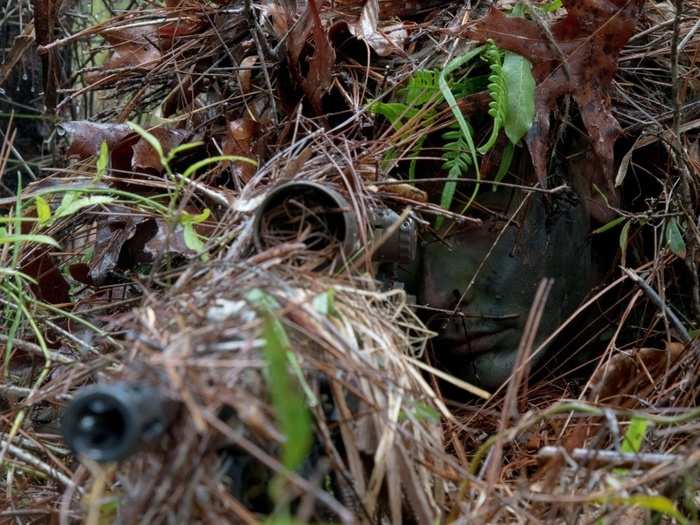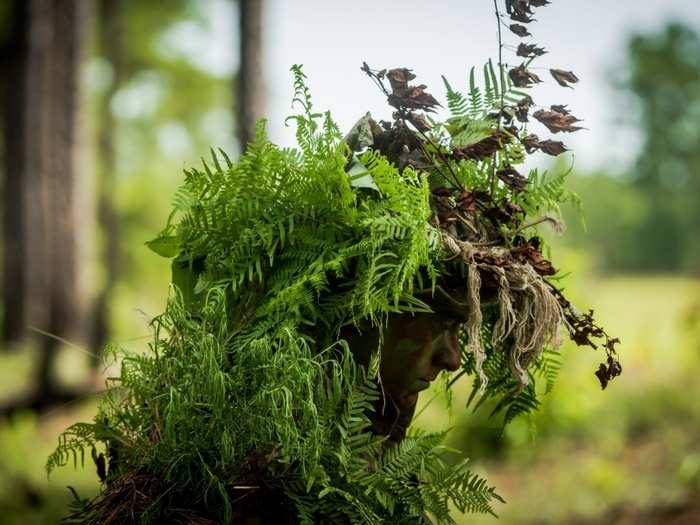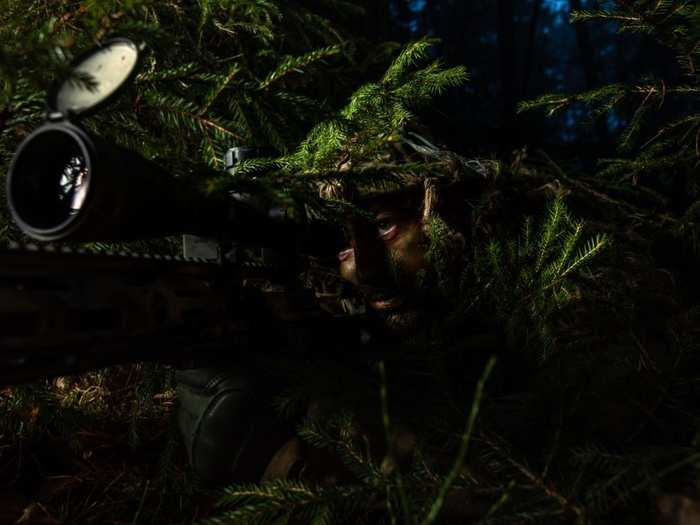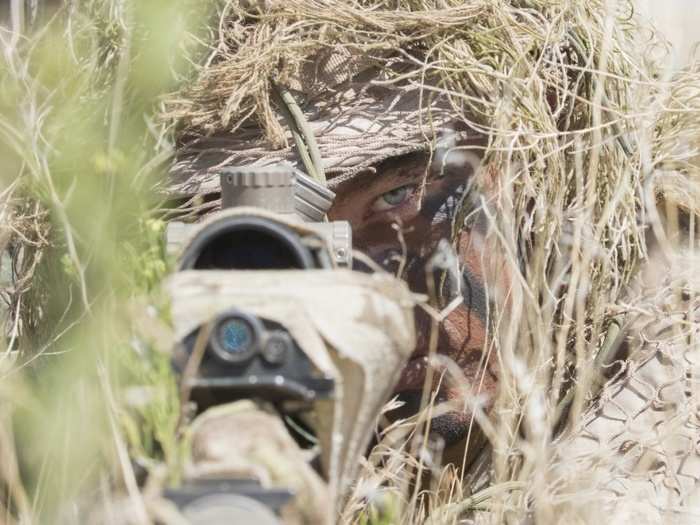- Home
- slideshows
- miscellaneous
- No one hides like a sniper - here's how America's deadliest sharpshooters disappear
No one hides like a sniper - here's how America's deadliest sharpshooters disappear
Concealment is about putting anything you can between yourself and the watchful eyes of the enemy.

In many ways, it's about knowing your environment.

"The best tool snipers can use to disguise and conceal themselves from the enemy is a solid understanding of their surroundings," Capt. Greg Elgort, the company commander, told BI.
Snipers need to know the lay of the land, they need to plan their route, and they need to take advantage of whatever nature gives.
"I want to look at the terrain. What can I put between myself and the target," Sipes, who runs the marksmanship training company alongside Elgort, said." It’s not just about the face paint or what I attach to my body, it’s the natural environment around me that I can utilize to keep them from seeing me."
For example, the winners of the International Sniper Competition, two non-commissioned officers from the Army's 3rd Ranger Battalion, 75th Ranger Regiment, hid themselves from view with nothing more than a ghillie suit hood and various materials they found in the field.
In particular, they focused on hiding their face.
"Just by being able to disfigure and break up the outline of their face — you know, a human face stands out very vividly in a woodland area — by concealing the outline of their face, they were able to win," Elgort explained. "It really comes down to an understanding of that and knowing what you’re presenting and adjusting accordingly."
There are a lot of small things that if overlooked could be fatal.

Snipers have to manage their tracks, scent, shadow, glare and countless other things to remain hidden from enemies. "There are a million things that go into being a sniper, and you have to be good at all of them," Sipes explained.
Here's just a few of the many things snipers have to think about.
"If you are facing east in the morning, the sun is going to be coming at you, so you need to do something with your scope to prevent glare," Elgort told BI. To combat this problem, snipers build cat eyes.
"We use natural vegetation, we use wraps, netting, whatever to block the optics from any observation but allow us to see through it," Sipes said, noting that other considerations include whether or not he is silhouetting himself against something else. A shadow could give away his position, exposing him to the enemy.
As for scents, he said that snipers avoid scented soaps, smoking, any type of cologne, deodorant, etc.
In colder climates, a sniper can eat snow to hide their breath, but it only works for a short time. "You would have to continuously eat snow, and then you have to pee," Smith said, bringing up another potential consideration.
Snipers also have to think about bodily excretions. Sometimes when nature calls, a sniper will use bags with sponges to soak up their business. They can also bury it in the earth. Other times, they just have to hold it.
Some environments are easier than others.

Staff Sgt. Joshua Jones, another sniper instructor, identified two decidedly difficult environments for concealment — fresh snow and the urban environments.
"You can disappear into the snow. It takes a little more thought. It’s a little harder to play with the blending in," he told BI. "And, in the urban environment, there’s just so many eyes on you from the onset that it makes it pretty tough for you to get into your setup without someone knowing that you’re already there."
Places like cities and suburbs are also the hardest areas to shoot in.
"I can say that the most difficult place to shoot is in an urban environment," Sipes said, calling attention to the some of the angles and structures obstructing visibility, among other problems.
"The targets are generally moving. They have civilians around them. They’re using the patterns of life on the ground to conceal themselves. And they’re never in one location," he added.
As for the easiest environments to blend into, that is definitely your standard woodland or jungle, Jones explained.
One of the greatest dangers is that new technologies are making it harder for snipers to hide.

The US is once again in a time rivalry with other military powers, and that means they must learn to counter more advanced threats from adversaries like China and Russia.
"Defeating a thermal signature is probably the hardest thing that a sniper has to do, especially with emerging technology by our near-peer enemies," Smith told BI. Snipers can hide in the visible spectrum, but combating high-end sensors is a challenge.
US rivals are starting to "creep into the thermal arena, and that in itself is dangerous to a sniper because then you can’t hide from that," Smith said. Thermal imagers can easily detect a human body's heat against the ambient temperature of the environment around it.
Smith called this a "large challenge" that the Army is "working to defeat that as well."
Sometimes that means getting back to the basics. Snipers often use laser range finders to get a more accurate read on a target, but that's not always an option.
"When going against a near-peer threat or an adversary that has the capability to identify that, we have to rely solely on the reticle that’s in our scope," Staff Sgt. Christopher Rance, a sniper instructor team sergeant from Colorado, explained.
Read More: The US Army's new camouflage will hide soldiers and tanks in plain sight — wherever they are
There are also new camouflage systems, such as the Fibrotex's Ultra-Light Camouflage Netting System capable of providing more persistent infrared, thermal, and counter-radar performance, that are in development to help the Army's snipers, as well as other soldiers, hide from the more advanced threats.
Warfare is always evolving, which means that US snipers have to be ready for anything.
Popular Right Now
Popular Keywords
Advertisement